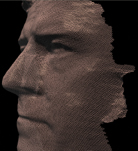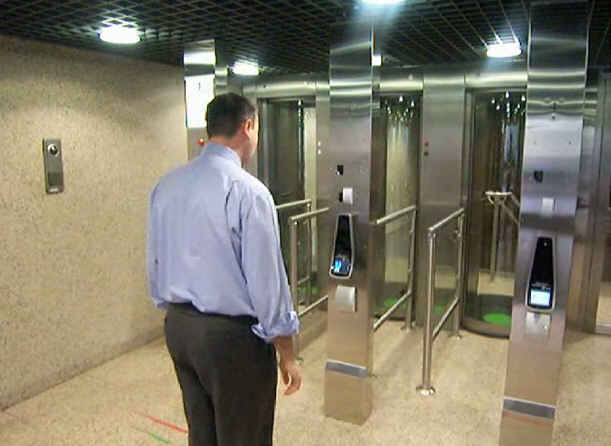Identity management and interoperable security initiatives are at the forefront of corporate and government agendas. Today, security directors are implementing new biometric technologies that increase entry point protection, secure assets, and reduce fraud and identity theft.
The initial focus of the emerging initiatives has been to improve the identification and authentication capabilities for several applications: secure access control; reduce identity fraud for government issued documents such as passports and visas; and to find more effective methods to identify known criminals. There are even more far reaching uses for biometric technology that range from secure financial transactions using biometric-enabled ATM and financial payment machines to computer logon security for corporate and home PCs.
By Kelly Richdale and Ryan Zlockie

WHY BIOMETRICS
Biometrics is an important part of increasing security and identification processing. For example, typical access control systems have relied on ID cards that can be stolen, lost, shared or copied. With a biometric image, such as a face or fingerprint image stored on the card, there is a secure and efficient way to ensure the person holding a card is the rightful owner. The same holds true for passports and immigration documents; in fact, a significant issue with fraudulent documents is solved with the use of biometrics.
Typically, there are three accepted ways to authenticate or prove identity within a system or to an authorized person.
-Something you have - like an ID card
-Something you know - such as a PIN number
-Something you are - a biometric, such as facial features, fingerprints, etc.
When two or more of these are used together for an identification decision it is called multi-factor authentication. Most applications such as access control or Civil ID applications (ePassport) use, at a minimum, dual factors: card/document plus biometric, which offers a very secure solution that exceeds using cards alone.
In verification mode, or (1:1) matching, the system verifies that the person belongs to the card or document by matching the biometric template stored on the card to the person standing in front of the access point and biometric device. There are some biometric technologies that can perform this matching process in less than one second for very fast throughput.
There are a variety of biometric technologies on the market, face, finger and iris being the most common. Every situation requires unique consideration in choosing a biometric or multi-factor solution. For example, at main entry points where volume throughput capability is critical to maintaining a normal flow of people traffic without interruption, it is imperative to have devices that are both fast and non-intrusive. There have been many advances in biometric technologies over the past few years with notable improvements in important categories -- security levels/accuracy; speed; and the user experience.
BIOMETRIC ADVANCES
|

|
|
3D recognition accommodates variable angles and covers more of the whole face.
(Photo by A4Vision) |
Some of the most recent and significant advancements in biometrics surrounding facial recognition have emerged with 3D facial technology. The new 3D technology employs completely unique methods applied to facial identification, very different than traditional forms of facial recognition. While introducing a third axis, depth, to the process there is immediately more facial data considered; accuracy improves exponentially with the ability to apply more mathematical probabilities to the data. 3D recognition accommodates variable angles and covers more of the whole face. In practice, speed improves proportionately with the new accuracy, because less processing time is required in the presence of precise information. 3D facial recognition performance accuracy has been shown to match or exceed fingerprint recognition; processing is faster; and it requires less user cooperation.
3D Facial recognition utilizes distinctive features of the face by capturing a real time 3D image of a person’s facial surface. The cranio-facial structure, where rigid tissue or bone is most apparent (eye socket curvature, nose, chin, etc.), represents the most unique areas of the face and those that are least likely to change over time. The following are some of the significant advantages that 3D facial biometric technology enables:
-Introduces depth and another axis of measurement whereby facial angles and curves can be measured on a sub-millimeter scale.
-Not affected by lighting conditions and may even be used in darkness.
-Robust to different view angles and has the potential to recognize a subject at near 30 degrees.
-Ability to perform verification matching in milliseconds.
The points above are very important to consider for access control or civil ID applications that require high throughput. For any biometric technology implemented there are several aspects that are required of the solution for successful deployment. These factors include a system that requires minimal cooperation from a subject, allows for flexibility in positioning and ambient light conditions, has a high level of accuracy, and is ergonomically designed to keep people moving quickly through secured areas.
ACCESS CONTROL
|

|
|
Facial recognition technology in use (Photo by A4Vision) |
With the recent achievements in biometrics, many are looking to enterprise-class, biometric-based physical access control systems. These biometric solutions-based networks can accommodate the need to incorporate fingerprint and facial recognition with existing physical access control systems.
Biometric verification ensures that a card holder is authorized for the security access level intended per individual, preventing card sharing or swapping, and thereby unauthorized accesses. Some facial recognition vendors can offer a solution that captures and stores a unique audit trail of access transactions, which includes a jpeg image of each access attempt. The photo images provide evidence, in case of theft or unauthorized attempted entries, for authorities using watch lists or conducting investigations. Biometric solution scenarios can be replicated and customized for any deployment.
Biometrics for access control has been widely and quickly adopted for airport employees, government workers, financial institutions and corporate sites. Effectively securing these sites requires providers to consider all laws, mandates and programs in place and be aware of frequent changes and revisions. Designing for systems and reader interoperability is key; and innovation in application will be required to create advantage while serving variable scenarios and addressing specific needs.
CIVIL IDENTIFICATION
Border Control Check Points
New generations of passports -- ePassports -- contain an RFID chip with an individual’s biometric image. These are already being rolled out in several countries. The biometric mandated for the new ePassports by ICAO (International Civil Aviation Organization) is a 2D photograph, and certain countries in the EU Schengen zone have opted to include fingerprints. At border checkpoints, biometric readers compare travelers’ live biometric images to a passport’s stored information to verify a match and ensure that the subject is who they claim to be. It is also possible to check against a criminal watch list to ensure that no criminals or expelled immigrants pass through the border.
3D face images may either be stored inside the passport or captured at the border & compared to the photo images in the passport to provide additional accuracy and robustness. This allows high volume screening of passengers through customs with a high level of security. 3D face recognition is in the process of ratification as an ISO standard, as an extension of the 2D face standard (ISO/IEC 19794-5:2005).
In the same way, biometric visas may be checked at the border to ensure that the person seeking to enter the country is indeed the same person as the one to whom the visa was issued. An increasing trade in asylum seekers and human trafficking means that passports containing visas to desirable countries are often used multiple times to allow “look-alikes” to enter that country. From 2007 onwards in Europe, visa stickers in passports will be linked to a central database of facial images and fingerprints. This ensures that a visa can be used only by one individual. In addition, prior to issuing the visa, the authorities may conduct a 1 to many search against the database to ensure that the applicant has not been rejected under an alias name.
Kelly Richdale is founder and senior vice president Worldwide Sales, and managing director EMEA of A4Vision SA. Ryan Zlockie is Director of Product Management at A4Vision (www.a4vision.com).
For more information, please send your e-mails to swm@infothe.com.
ⓒ2007 www.SecurityWorldMag.com. All rights reserved.
|



